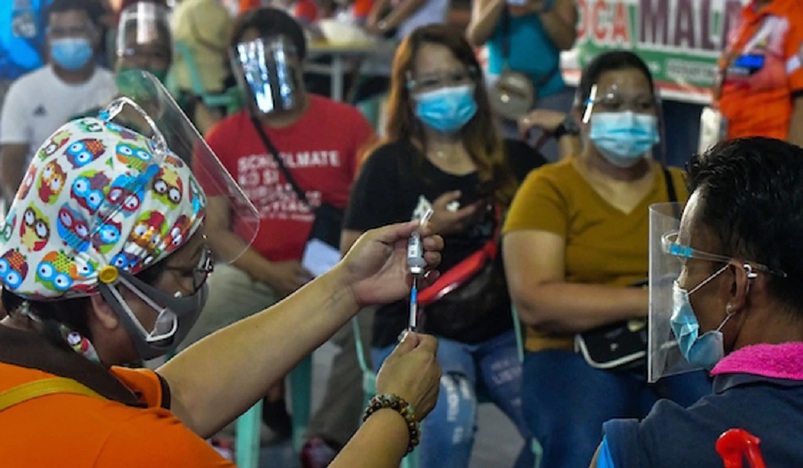
Caloocan City residents booked online receive their dose of a COVID-19 vaccine at the Notre Dame of Greater Manila vaccination site on August 16, 2021.
MANILA - The Philippines' daily COVID-19 cases have declined due to its wide vaccination program, OCTA Research said Sunday.
The nation's reproduction number, or the number of people infected by a virus patient, is at 0.52, according to Guido David. A virus reproduction rate of less than 1 is ideal, authorities earlier said.
Average daily infections nationwide also declined last week by 35 percent to 4,500 from 8,400 the previous week, David said.
"Isa sa madaling paliwanag ay medyo marami na tayong nabakunahan. Aside from that, meron ding may dala ng antibodies dahil previously infected na sila," he told ABS-CBN's TeleRadyo.
(One of the easy explanations is we have vaccinated many individuals. Aside from that, others who have been previously infected carry antibodies.)
"Pag pinagsama natin ito, maaaring hindi pa siguro tayo nasa herd immunity, pero medyo malapit na tayo. Nasa population protection na tayo (sa Metro Manila)."
(If we combine their numbers, we might not have achieved herd immunity yet but we're near that already. We've achieved population protection [in Metro Manila] already.)
Vaccine czar Secretary Carlito Galvez Jr earlier said 81 percent of Metro Manila's eligible population have been fully vaccinated.
The government aims to inoculate at least 77 million all over the country to achieve herd immunity as more transmissible variants emerge.
The Philippines has so far fully vaccinated 25.1 million individuals while 29.3 million have received their first dose, according to government data. The vaccination drive kicked off March 1.
In June this year, Galvez said that if 19 to 25 million in the country are fully vaccinated against COVID-19, population protection is achieved, containing death and hospitalization.
The country's daily virus cases might drop to 3,000 next month, and 2,000 to 1,000 by December, David said. Lawmakers earlier criticized OCTA Research, which said it uses data from the health department, for the accuracy of its COVID-19 projections.
The capital region's COVID-19 reproduction rate is at 0.47, and its daily cases last week averaged at 967 versus 1,679 the previous week, David added.
"Dahil marami nang protektado, kumabaga wala nang kinakapitan yung virus masyado," he said.
(Because many people are protected, few contract the virus).
"Ang kinakapitan nito ay mga unvaccinated or yung mga vaccinated na may comorbidity or di masyado nakakagawa ng antibodies ang katawan nila kaya sila nakakakuha ng virus."
(The virus attacks those unvaccinated or vaccinated persons with comorbidity or whose bodies cannot make enough antibodies.)
The downward trend of the country's virus cases began when Metro Manila was placed under modified enhanced community quarantine (MECQ), David said.
"Malaki ang tinulong ng ECQ, MECQ. Nung lumipat tayo sa Alert Level 4, nasustain ang downward trend," he said.
(ECQ and MECQ were a great help. When we shifted into Alert level 4, we sustained the downward trend.)
"'Di pa tayo nakakakita ng spike sa Alert Level 3, pero 'di ibig sabihin na pwede na tayong magpabaya."
(We've yet to see a spike during Alert Level 3, but it doesn't mean we can be complacent.)
The Department of Health earlier this month confirmed that the decline in the country's virus cases were "not artificial" but it urged the public to remain vigilant.
The Philippines has recorded a total of 2,751,667 confirmed COVID-19 cases, of which 63,051 are active, as of Sunday, according to the DOH.
Source: ABS-CBN
.jpg)
Qatar Secures Place Among the World's Top 10 Wealthiest Nations
.jpg)
Hamad International Airport Witnesses Record Increase in Passenger Traffic

Saudi Arabia: Any visa holder can now perform Umrah

What are Qatar's Labour Laws on Annual Leave?
Leave a comment